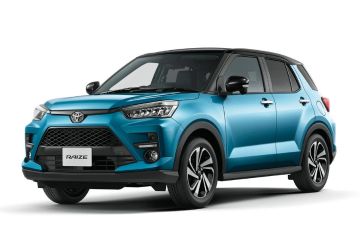![CVT vs. Dual-Mode CVT vs. Direct Shift-CVT: Which one is better? 01]()
Continuously variable transmissions (CVT) have slowly begun to replace traditional automatic gearboxes in modern vehicles.
CVTs provide a near-infinite number of “gear ratios” vehicles can use to optimize fuel economy and daily driving performance. It lets the engine operate at its most efficient range by assigning ratios according to driving conditions.
Now that CVTs have become mainstream, this gearbox is seeing new versions of itself as automakers adapt and further enhance this new technology. It also isn't short of detractors who see CVT technology as expensive to maintain and less durable than traditional torque converter-equipped automatics. But that's another story altogether.
This article will quickly discuss two of the latest CVT derivatives from Toyota and Daihatsu/Perodua, as seen in the Toyota Raize and the recently unveiled Perodua Axia. Both attempt to tackle a well-known issue of CVTs by employing similar approaches but differing solutions.
We will cover what makes them unique and how they differ from one another despite sharing the same acronym.
Also read: 2023 Perodua Axia previewed in Malaysia, is the next-gen Toyota Wigo coming soon to the Ph?
Continuously Variable Transmission (CVT)
We start with the Continuously Variable Transmission. It is a type of transmission that seamlessly changes through an unending range of gear ratios while you drive.
This transmission uses a pulley system with two cones at each pulley connected with a chain belt. The cones can move to increase or decrease the belt diameter to change the gear ratios. This movement allows quick shifting into the needed gear ratio for increased power or better fuel economy.
One pulley of the CVT is connected to the engine, while the other directs power to the front wheels. The width of these pulleys changes based on the needed power; as one pulley gets larger, the other gets smaller, allowing stronger and more seamless acceleration.
A second type of CVT also uses discs and rollers instead of the pulley and cone system. Regardless, it still employs the same principles.
While a CVT typically has no set gears, it can simulate them by moving the belt and pulleys to designated presets. These “gear changes” are done with the help of the car’s computer and a traditional shift lever or paddle shifter.
Now that we have tackled what a CVT is, we can tackle its spin-offs from Toyota and Daihatsu.
Toyota Direct Shift-CVT
![CVT vs. Dual-Mode CVT vs. Direct Shift-CVT: Which one is better? 01]()
We first start with Toyota’s Direct Shift-CVT. It is a combination of both a gear drive set and a belt-driven CVT.
The transmission uses a predetermined "first" gear to move the car from a stop, similar to what you would find in a traditional automatic gearbox or a manual transmission.
This allows the car to have a steadier launch without the possible slip and rubber band effect of a CVT, a common issue with this transmission type.
Once the vehicle is in motion, the transmission will swap over to the pulley and cone system.
Swapping over to the traditional CVT part of the transmission will allow the vehicle better variable ratios while cruising on the highway or at higher speeds for better fuel economy.
Daihatsu Dual-Mode CVT (D-CVT)
![CVT vs. Dual-Mode CVT vs. Direct Shift-CVT: Which one is better? 02]()
Unlike a conventional CVT, the Daihatsu/Perodua Dual-Mode CVT doesn’t rely on a belt drive system to get the car going, and it instead uses split gears into the mix to further improve efficiency. There are additional gears and a planetary gear set fitted to the input and output shafts of the pulleys, with a clutch pack to engage or disengage the latter.
![CVT vs. Dual-Mode CVT vs. Direct Shift-CVT: Which one is better? 03]()
Simply put, the transmission works like a traditional CVT at lower to medium speeds, and only when you enter higher speeds, such as when on the highway, does the gear drive kick in.
The logic here is that the CVT side of the transmission deals with acceleration while the gear drive side deals with highway speeds and cruising for maximum efficiency and less energy loss.
![CVT vs. Dual-Mode CVT vs. Direct Shift-CVT: Which one is better? 04]()
It works opposite to the Direct Shift of Toyota but uses the same principles for better performance and fuel economy.
So which is the better transmission?
Deciding on which is the better transmission will depend on the use case.
For Toyota, its Direct Shift-CVT works best for its vehicles as it has a broader range of models. It can be used on smaller vehicles, such as the Wigo, and even cater to bigger cars, like the Lexus UX and Toyota RAV4.
In the case of Daihatsu, its transmission has a torque limit. The Daihatsu Dual-Mode CVT can only handle engines that produce less than 150 Nm of torque; any more than that could cause belt slippage and issues with the reliability of the transmission.
Daihatsu also says its transmission is optimized for all its models, from mini (kei cars) to vehicles with engine capacities of up to 1.5 liters.
So, the application is critical here as Daihatsu specializes in smaller vehicles, like the Perodua Axia/ Toyota Wigo twins, while Toyota's Direct Shift-CVT has a broader model range.
An example of both transmissions being used is in vehicles shared between the automakers, such as the Daihatsu Rocky or Toyota Raize. Both transmissions can be used with the crossover as it meets their criteria.
At its most powerful, the Raize makes 140 Nm of torque which is well below the limit of the Dual-Mode CVT. It also works well with the direct shift of Toyota without any issues giving the vehicle a more natural feel when setting off.
So where does the Dual-Mode CVT pair best?
The Daihatsu Dual-Mode CVT is best paired with the naturally aspirated engines, as power comes on linearly. In contrast, the Toyota Direct Shift-CVT can handle the higher torque generated by a turbocharged engine.
The Dual-Mode CVT also works with lower-torque and small cars such as the Wigo and Axia. On the other hand, the Direct-Shift transmission can be applied to larger vehicles such as the Toyota Vios and the Toyota Altis.
Something to note is that while efficient, traditional CVTs also have limits on how much power they can handle. This limit is around 250 PS and 339 Nm of torque or when the steel belt starts slipping. Note that this limit differs per manufacturer and is a general ballpark for CVTs.
Has this story helped you understand the latest tech in CVTs better? Would you get a car equipped with either one of these?










